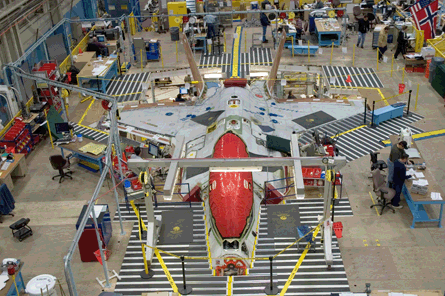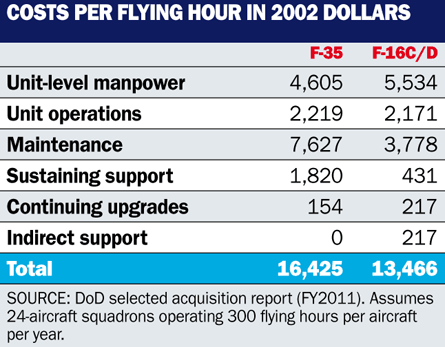Perhaps the most alarming figure yet associated with the Lockheed Martin F-35 programme is in the last line of a 53-page cost estimate prepared in late 2010 by the US Department of Defense.
The figure on the page reads: "1005342.0". Given the million-dollar unit, this translates in rounded figures to $1.01 trillion, and represents what the DoD expects to pay in inflation-adjusted dollars to operate and sustain 2,443 F-35s over a planned 50-year service life.
It is a figure that even Vice Adm David Venlet, F-35 programme chief, has described as rendering his customers in three US armed services "weak in the knees".
 |
|---|
© Lockheed MartinThe F-35 may have become more efficient, but DoD policy changes for cost estimates have increased the maintenance bill, says Lockheed |
And the trillion-dollar-busting estimate for operations and sustainment costs comes on top of another inflation-adjusted cost projection - $379.4 billion, to develop and produce all 2,443 F-35s - that Venlet's boss, undersecretary of defence Ashton Carter, has described under oath as simply "unaffordable".
Addressing a 19 May hearing by the Senate Armed Services Committee, Carter noted that, in general, operating and sustaining a weapon system consumes 70% of all lifecycle costs, with the remainder spent on research, development, testing and procurement.
"Seventy cents of the cost of every programme is having it, 30¢ is getting it," said Carter. By that reckoning, the $1 trillion figure for F-35's operation and support costs suggests that the DoD is getting a bargain.
With a $379 billion total acquisition cost, the projected bill for operations and support represents a comparatively inexpensive 62% of lifecycle costs. For the F-35 programme to correspond with Carter's rule of thumb for weapons systems, the operations and support bill for the F-35 would have to rise to nearly $1.3 trillion over a half-century of service.
The cost figures are so eye-popping that Carter was forced to take the awkward position of disavowing estimates generated by his own staff as part of a congressionally mandated reporting requirement. "You shouldn't believe [the estimates]," Carter told the Senate panel, "because we haven't really begun to manage them yet. They are parametric forecasts. Nobody's going to pay that bill."
Carter noted that he had made the same argument at a meeting in April of the leaders of the eight F-35 partner countries: "I said, 'If you thought that was really going to be the bill for sustaining the airplane, we might as well all get up and go out and leave now.'"
RISING COST TREND
But the rising cost trend cannot be disregarded. The DoD's estimates show operations and support costs have risen dramatically higher than procurement costs over the past decade. While projected acquisition costs have soared 55% in constant dollar terms, the operations and sustainment estimates have jumped by nearly 178% compared with the original DoD forecast of December 2001.
Lockheed Martin chief executive Robert Stevens is careful not to offer excuses, but he has pointed out that one explanation for the soaring operations and support cost growth is partly explained by a change in how the DoD's predictions are calculated. The original model in 2001 was based on a 30-year lifecycle cost. The DoD policy changed in 2006 to calculate costs over a 50-year lifespan, Stevens said.
"Now I don't know about a lot of things in economics," said Stevens, formerly Lockheed's chief financial officer, "but I know when we're talking about total costs if you move from 30 years to more than 50 years that cost is going to go up, and it could go up even when the unit costs are getting much more efficient around that jet."
Operations and sustainment costs could change if programme officials carefully inspected the "ingredients" that the model was based on, Stevens suggested: "When you develop a model that big there are sufficient opportunities to reduce that number by making streamlining decisions along the way."
 |
|---|
That idea has become the US government's major goal as Vice Adm David Venlet enters his second year as F-35 programme executive officer. In his first year, the focus was on analysing the true costs of the development and early procurement phases. That process - which added $4.6 billion to the development price tag and delayed in-service date by at least two years - is nearly complete.
"We have some choices about how we sustain and support this aircraft," Venlet said. "We need to illuminate the consequences of those choices principally in cost - and it's not just the US." The cost estimates are based a wide range of assumptions. In a briefing on 21 April, Venlet focused on one particular input: basing. He suggested that if the three US armed services buying different variants of F-35 co-located, that could reduce the number of simulators required, which is one of the major drivers of costs. And he indicated that Lockheed's grip on the performance-based logistics deal for the F-35 could be re-evaluated. "We will let 'actuals' from fleet experience teach us the right way to incentivise industry and how we contract with them," he said. "We do believe there is a balance. There's a balance of organic support in US depots with industry support."
Lockheed's Steve O'Bryan, vice-president of F-35 business development, notes that the performance-based logistics contract facilitates such a re-evaluation, as it "allows you to examine those costs. If the [manufacturer] repair is best value, that is the logical place to do the repair. If the depot is best value, you can move that work. You can compete it."
The F-35 is still expected to cost significantly more to operate than the aircraft it replaces. "Sustainment seems like years away," Carter said, "but now is the time to face that bill and begin to get that under control."
Source: Flight International



















